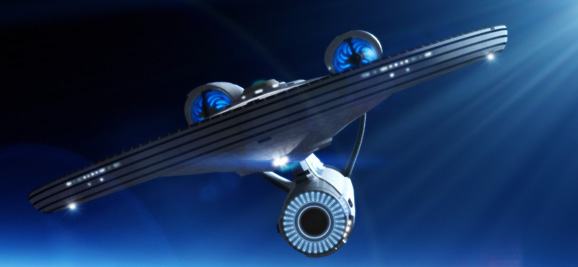The Starship Enterprise’s Dark Nuclear Past

Co-authored by Paul Carroll and Ben Loehrke
Star Trek: Into Darkness is the latest in the decades-old Star Trek franchise. To date the film has grossed nearly $160 million at the box office. Not bad for its first week. After all, it cost about $190 million to make, so it seems poised to break even very soon.
Unless, that is, you count the cost of one of the film’s key props. The “prop” used for the warp core – a significant feature of Starfleet vessels – would put the film’s cost at more than $5.2 billion. Even James Cameron would blush.
Why such a huge price? Well, the “warp core” scenes use an actual U.S. taxpayer-funded superlaser at California’s Lawrence Livermore National Lab (LLNL). The “National Ignition Facility (NIF),” the laser’s official name, is in a way it is on its own “star trek.” The NIF, in theory, creates a miniature nuclear fusion explosion like that of a star. Bringing “star power to Earth” is the motto of the lab. But the real mission of the NIF is much less benign. The conception, design and construction of the NIF is part of the Department of Energy’s (DOE) “stockpile stewardship program” to maintain thousands of nuclear weapons well into the 21st century. This is where life imitating art gets really scary.
For those non-Trekkies out there, it may surprise you to know that in Star Trek lore, 21st century Earth plunges into global turmoil after a nuclear exchange during World War III. Admittedly, we’re not as smart on Star Trek lore as other staff members. But here’s how Memory Alpha’s Star Trek wiki sums up Earth’s nuclear history (future?):
Humanity's fear of nuclear holocaust was nonetheless realized beginning in circa 2026 with the Third World War. Six hundred million were killed and major cities were destroyed, many through use of atomic weapons....
large populations of Humans were bombed out of existence, and the survivors were placed in jeopardy by radioactivity, supply shortages, and the collapse of most of the major governments.
“In universe,” as they say, people call this time after the WWIII exchange the “post-atomic horror” that lasts well into the 22nd century. Sounds pretty unpleasant, right?
So if Earth’s real life timeline merges into Star Trek’s storyline, human civilization has a solid 13 years before nuclear apocalypse – in part thanks to the nuclear weapons work provided by the NIF, featured in Star Trek: Into Darkness.
Star Trek’s nuclear horror is fiction, as far as we know. But the costs of NIF are all too real. In 1994, NIF was supposed to cost about $1 billion. Latest estimates put the facility at about $5 billion. For all the cash it’s burning up – a requested $401 million in FY14 alone – NIF continues to fail at achieving ignition – resulting in chronic delays and cost overruns.
In this budget climate, sustaining that level of funding is about as affordable as building an actual Starship Enterprise. There is increasing congressional weariness about NIF’s mounting bills, slipping timelines and dim prospects.
The producers of Star Trek: Into Darkness – and especially the government caretakers of the NIF – happily stressed that the film producers compensated the government for any costs of using the facility as a prop. That’s generous of them and, given the film’s box-office success, they can certainly afford it.
The question now is will the nuclear contractors repay taxpayers for NIF’s failure? Or, if Star Trek’s nuclear horror comes to pass, would the nuclear contractors pick up the tab for the collateral damage?




